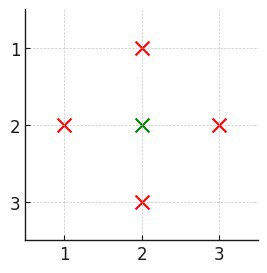Description
You are given a positive integer n, representing an n x n city. You are also given a 2D grid buildings, where buildings[i] = [x, y] denotes a unique building located at coordinates [x, y].
A building is covered if there is at least one building in all four directions: left, right, above, and below.
Return the number of covered buildings.
Example 1:

Input: n = 3, buildings = [[1,2],[2,2],[3,2],[2,1],[2,3]]
Output: 1
Explanation:
- Only building
[2,2]is covered as it has at least one building:<ul> <li>above (<code>[1,2]</code>)</li> <li>below (<code>[3,2]</code>)</li> <li>left (<code>[2,1]</code>)</li> <li>right (<code>[2,3]</code>)</li> </ul> </li> <li>Thus, the count of covered buildings is 1.</li>
Example 2:

Input: n = 3, buildings = [[1,1],[1,2],[2,1],[2,2]]
Output: 0
Explanation:
- No building has at least one building in all four directions.
Example 3:

Input: n = 5, buildings = [[1,3],[3,2],[3,3],[3,5],[5,3]]
Output: 1
Explanation:
- Only building
[3,3]is covered as it has at least one building:<ul> <li>above (<code>[1,3]</code>)</li> <li>below (<code>[5,3]</code>)</li> <li>left (<code>[3,2]</code>)</li> <li>right (<code>[3,5]</code>)</li> </ul> </li> <li>Thus, the count of covered buildings is 1.</li>
Constraints:
2 <= n <= 1051 <= buildings.length <= 105buildings[i] = [x, y]1 <= x, y <= n- All coordinates of
buildingsare unique.
Solution
Python3
class Solution:
def countCoveredBuildings(self, n: int, buildings: List[List[int]]) -> int:
rows, cols = len(buildings), len(buildings[0])
R = defaultdict(list)
C = defaultdict(list)
res = 0
for x, y in buildings:
R[x].append(y)
C[y].append(x)
for k in R.keys():
R[k].sort()
for k in C.keys():
C[k].sort()
for x, y in buildings:
rIndex = bisect_left(R[x], y)
cIndex = bisect_left(C[y], x)
if 0 < rIndex < len(R[x]) - 1 and 0 < cIndex < len(C[y]) - 1:
res += 1
return res